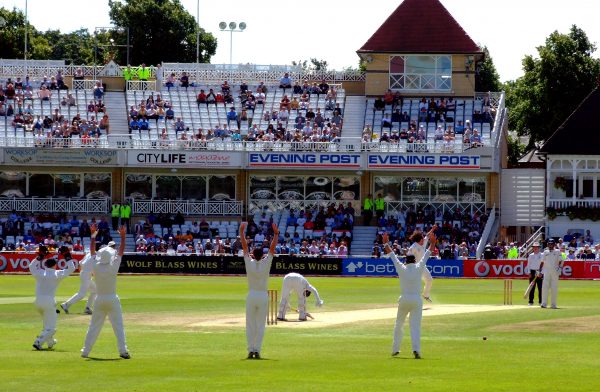
“Howzat?”
“Kaaaaach it!”
“Bowled ‘im!”
“Wadda wrong’un!”
Americans may scratch their heads at these expressions, but a large body of international sports fans relishes those words. England and Wales are currently hosting the Cricket World Cup, the 12th edition of the tournament that began in 1975; ten national teams who have made it past qualifiers are slogging it out to lift the trophy. Social scientists around the world have studied cricket — as with many sports, a social science perspective on cricket shows that the pitch and stumps reside at a complex intersection of globalization, postcolonialism, boundaries, and identity.
Cricket is a global sport based on institutional and organizational processes as well as broader patterns of cultural and national identity. The centuries-old sport started in the United Kingdom and has since spread into a worldwide, modernized phenomenon, complete with fireworks, cheerleaders, and sophisticated analytics. An international network of cricketing organizations, athletes, broadcasting companies, sponsors, and state actors bring the game to its large, global audience.
- Jason Kaufman and Orlando Patterson. 2005. “Cross-National Cultural Diffusion: The Global Spread of Cricket.” American Sociological Review 70(1): 82-110
- Jon Gemmell and Boria Majumdar. 2007. Cricket, Race and the 2007 World Cup. CRC Press.
- Devra Waldman and Brian Wilson. 2017. “Behind the Scenes of Sport for Development: Perspectives of Executives of Multinational Sport Organizations.” International Review for the Sociology of Sport 52(6): 651-674.
In several countries, cricket’s growth has been shaped by the dilemmas, challenges, and sticky wickets of decolonization. In these countries, cricket has played an important role in building new cultural and national identities; social scientists explain that the popularization of cricket is both a cause and consequence of broader change. South Asian nations today are key players and decision-makers in the international cricketing world, which reverse-sweeps conventional logic that white countries hold greater global power.
- Boria Majumdar. 2007. “Nationalist Romance to Postcolonial Sport: Cricket in 2006 India.” Sport in Society 10(1): 88-100.
- Colin Agur. 2013. “A Foreign Field No Longer: India, the IPL, and the Global Business of Cricket.” Journal of Asian and African Studies 48(5): 541-556.
- Kaushik Bandyopadhyay. 2013. “Cricket as Nationalist Obsession: ICC World Cup 2011 and Bangladesh as a Host Nation.” Sport in Society 16(1): 19-32.
The cricket field can also tell us a lot about race, belonging, and hierarchy. A classic in the social science of sport, C.L.R. James’ Beyond the Boundary uses his tales playing cricket to highlight status, exclusion, prejudice, and inequality within a social world shaped by racism, colonialism, and resistance. For example, he describes how team selection in cricket was shaped by skin-color rather than skill. Today, James’ ideas still influence scholars who study cricket as relevant to race, group boundaries, and social movements. Some researchers have studied anti-racist activism and the pursuit of equitable cricket representation in countries grappling with racial inequality. Others have shown that cricket offers an avenue of legitimization for marginalized and underrepresented groups in such nations.
- Goolam Vahed. 2001.”‘What Do They Know of Cricket Who Only Cricket Know?’: Transformation in South African Cricket, 1990-2000.” International Review for the Sociology of Sport (36)3: 319-336.
- Karen Farquharson and Timothy Marjoribanks. 2006. “Representing Australia: Race, the Media and Cricket.” Journal of Sociology 42(1): 25-41.
- Stephen Wagg. 2007. “‘To Be an Englishman’: Nation, Ethnicity and English Cricket in the Global Age.” Sport in Society 10(1): 11-32.
- Thomas Fletcher and Thomas Walle. 2014. “Negotiating Their Right to Play: Asian-specific Cricket Teams and Leagues in the UK and Norway.” Identities 22(2): 230-246.
Unfortunately, many issues of exclusion and marginalization still exist in the cricketing world today, both within and across different nations. As cricket continues to grow, globalize, and gather, such issues will hopefully be firmly driven outta here from the middle of the bat.
For an explanation of cricket terms, visit this ESPN glossary.

Comments